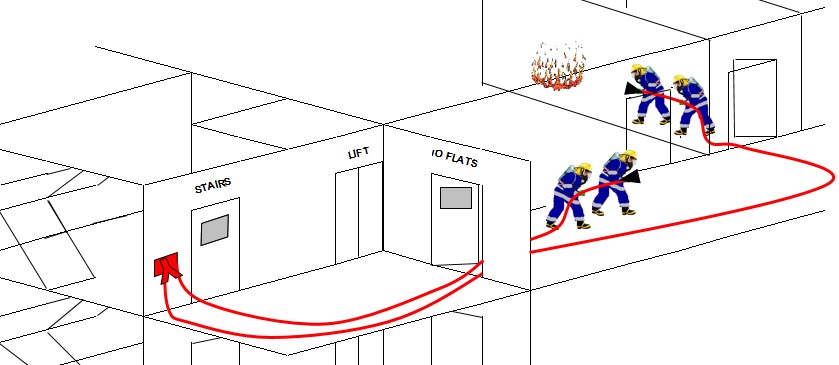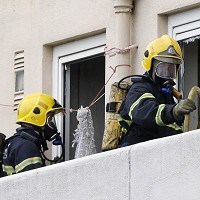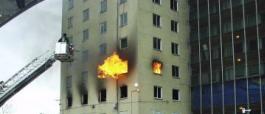The two line intervention is the absolute minimum that should be deployed for a fire whose size and development can not be fully ascertained. It should always be backed up with an additional third line as soon as resources permit.
Two line tactics are usually reserved for rescue scenarios, but if the IC feels that the immediate deployment of two lines will have a major impact in mitigating the development, acceleration or fire spread beyond the flat, then this may be used.
This tactic poses an elevated risk, in that no crews are protecting or monitoring the means of egress (stairwell)
Deployment of two line tactics
A PROPOSED FORMAT FOR A 2 Line (Crew of 8)
Whenever possible the Medium risk zone should be immediately evacuated by the reconnaissance team. The actions of opening the compartment will undoubtedly cause smoke logging in the corridor. Although occupants in unaffected flats in the Medium risk zone should be protected by the compartmentation of the building, this may be difficult to rely on without solid pre-incident intelligence. Also,during the intervention, the occupants may panic and attempt to evacuate or self-rescue.
The first attending appliance crew will form the reconnaissance team (2 x Ff and 1 X ICS L1)
The Pump operator of the first attending appliance sets up the dry riser supply.
The reconnaissance team advance to the incident location where the intelligence they have gathered so fare indicates to the IC that a two line attack would be the most suitable tactic.
The Reconnaissance team set into the dry riser outlet and lay out one line of hose, long enough to make full penetration into the affected flat.
As more resources attend, a second team are assembled ( 2 x Ff with BA and 1 x Entry Control Officer (ECO)) who liaise with the reconnaissance team.
The IC of the reconnaissance team now becomes Sector Commander Bridgehead and the OIC of the second arriving appliance will become overall IC
The SC Bridgehead will call on the second team and reconfirm the incident floor.
On arrival of the second BA team and ECO, a second line of hose is connected to the riser outlet and laid out.
The IC conducts a risk assessment in conjunction with the SC Bridgehead and confirms, by using internal and external observation, that compartment entry is viable.
Dry Riser is charged and both hose lines are charged.
The two BA teams then start up their BA sets in clean air as close to the point of compartment entry as possible. If compartmentation is absent within the corridor, the identify a location risk assessed as safe for this purpose.
The BA board is then taken by the ECO to establish the ECP at the bridgehead (the location of which is identified to the BA wearers prior to their committal to allow accurate wear planning).
All further BA teams will be committed from the bridgehead through this ECP.
The Sector Commander Bridgehead also relocates to the bridgehead.
The BA teams initiated the rescue as follows;
1X BA team of two enter the compartment with a fire fighting jet to conduct the rescue.
1X BA team of two remain at entrance to the compartment with a safety/covering jet to provide emergency support the rescue team.
Entry may only be made to flat where an entry is assessed as viable and the benefits to an early entry will be substantial. If any doubt regarding the safety of personnel undertaking such actions exists, no intervention should be undertaken.
It is normally a requirement to evacuate the primary risk zone (any adjoining corridor or hall that may become involved) prior to undertaking two line intervention.
The IC’s risk assessment will have considered the likelihood of fire spread beyond the affected compartments fire resistance measures (based on the signs and symptoms of fire identified by the reconnaissance team) prior to implementing this tactic.
SET ALLOCATION OF INITIAL TASKS (Critical task analysis)
In order to facilitate the two line (fire compartment rescue) 1 without delay, the following set tasks should be nominated, in order, to the first eight relevant personnel attending as part of the initial attendance.
1 X ICS L1 = IC (reconnaissance team) and Sector commander Bridgehead.
2 x Ff = BA wearers (reconnaissance and rescue team)
1 x Ff = pump operator
2 x Ff = BA wearers (to support the rescue team)
1 X Ff = ECO
1 x ICS L1 = External (Overall) IC
Total = 2 x ICS L1, 6 x Ff.
The nomination of these set tasks will allow the additional 2 BA wearers and ECO required to support the reconnaissance team in order to conduct identified fire compartment rescue(s) without delay.
The role of the external observer is a vital in providing fire development information to support overall tactical planning, but also to identify the trapped occupant trigger, and support the fire compartment rescue risk assessment of the Sector Commander Bridgehead. Therefore, to ensure this information is available, an external check of the building MUST be undertaken by the external IC or (if available) a dedicated external observer.
If the IC has carried out the external observation then a dedicated external observer must be nominated as the next allocated task as soon as resources permit. It is also recommended that this task be maintained throughout the dynamic stages of the incident. This role should be undertaken by a qualified BA wearer to ensure that they can identify and communicate signs and symptoms of fire development to the IC.
It is critical that this two line attack is augmented to a full three line attack with BA emergency crews as soon as resources permit
 This link will take you away from www.highrisefire.co.uk Please be aware that we do not necessarily endorse or support the views, opinions and expressions of this site !
This link will take you away from www.highrisefire.co.uk Please be aware that we do not necessarily endorse or support the views, opinions and expressions of this site !



